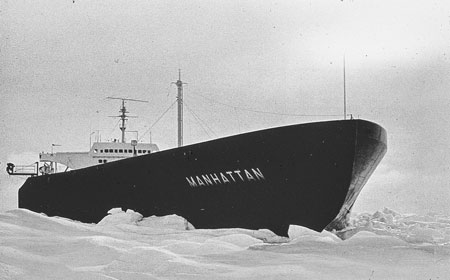
Length: 1,005 feetBeam: 148 feetDisplacement: 115,000 tonsSpeed: 17 knots (20mph)Ice Capacity: 15 feet
History: The SS Manhattan was built as an oil tanker in 1962 and was converted
into an icebreaker in 1968-1969. It was the largest tanker in America and was
converted into an icebreaker to sail through the Northwest Passage to Alaska, where
an estimated 40 billion barrels of crude oil was discovered under the frozen tundra
of the state’s northern slope.
Lukens Steel Company in Coatesville, PA supplied almost 5,000 tons of steel for
the Manhattan’s conversion project. More than 1,100 tons of Lukens ABS
Hull Structural Steel was used to strengthen the ship’s forward section and
286 tons of plate for the bow section. The new bow featured design techniques
that increased the Manhattan’s icebreaking abilities up to 60%. It lifted
the ship up onto the ice, allowing the weight of the ship to break through it.
Lukens plates were also used in the “ice belts” that were placed around
the hull for the protection from ice floes.
The SS Manhattan successfully became the first commercial vessel in history to
fully navigate the Northwest Passage to Alaska in 1969. Her success was due
to the converted icebreaker bow and added ice belt reinforcements, all made with Lukens
steel. During the passage, the Manhattan was able to break through ice as thick
as 15 feet. The ship returned home with two holes in its side, a part that was
not modified for ice. Lukens then supplied additional steel to repair those
holes. The Manhattan remined in service until 1987 and then was scrapped.
